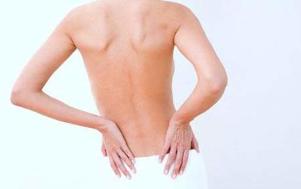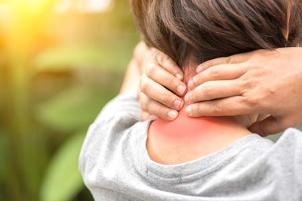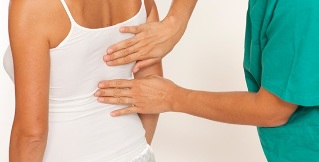
The spine performs the most important functions in the human body. In this article you will learn all about what is osteochondrosis, what are the symptoms and treatment of this disease, what are the signs of pathology and the causes of the disease.
What is osteochondrosis
Osteochondrosis is a disease that affects the intervertebral discs and other tissues of the spine. Dystrophic processes are triggered inside the spine. The vertebrae seem to compress, crushing these discs, which gradually leads to pinching of the nerve endings of the spinal cord.
Important! If osteochondrosis is not treated, the pathology can cause damage.
About 80% of the world's population suffers from spinal pathologies. Osteochondrosis is most often diagnosed in people aged 15-30 years. Although the disease occurs in both men and women, the strong half of humanity has a harder time with the disease.
The disease begins to develop and manifest itself in relatively adulthood, when a person leads an active life. Although osteochondrosis is possible in children, it is much less common than in adults.
Despite the fact that experts from all over the world have joined forces to eradicate the disease, new cases of osteochondrosis are registered every year. Whether problems will arise depends a lot on the personal efforts of the individual.
Existing classification
There are many types of osteochondrosis, so different doctors may apply different classifications.
Depending on which part of the spine is affected, there are:
- cervical osteochondrosis;
- osteochondrosis of the thoracic spine;
- osteochondrosis of the lumbar spine;
- osteochondrosis of the sacral region.
There is also extensive osteochondrosis. This is a form of pathology in which several departments are affected at once. For example, osteochondrosis of the lumbosacral region is often found because it is this part of the spine that is constantly under increased stress.
Whatever kind a person encounters, complications are always severe. That is why it is important to identify the disease as soon as possible and to provide qualified first aid.
When the doctor makes a diagnosis, he notes at what stage the pathology is detected. In osteochondrosis, there are 3 stages according to the picture of X-ray examination and 4 stages according to the symptomatic changes.
What happens during pathology
Almost all vertebrae have a similar structure. They consist of a vertebral body and an arch. All vertebrae, "folded" together, form a spinal canal. The discs are located between the vertebrae - jelly-like tendons that act as shock absorbers.
It is in the intervertebral discs with osteochondrosis that the pathological changes begin. The fibrous part gradually becomes more fragile. Under the pressure of the vertebrae, the nucleus pulposis makes a move for itself and looks for a place where it is easiest to do it.
In most cases, the disc exits the spinal canal. This leads to compression of the spinal cord and nerves located there. The result is pain and symptoms in the organs for which these nerves are responsible.
In response to pressure in the body, the processes of accelerated separation of bone tissue are activated. As a result, the development of osteophytes begins - bone growths that cause people the main problems with osteochondrosis.
So, in osteochondrosis of the cervical spine, the consequences can be sad, as the pathological process affects both the nervous and vascular systems.
Causes of osteochondrosis
Because osteochondrosis is a dangerous enemy, it is important to understand what causes the onset of the disease. No matter where the disease is located, the causes are always similar.
The main reasons why osteochondrosis can develop are the following:
- premature aging of the tissues in the intervertebral discs;
- constant strain on the muscles supporting the spine;
- lack of reasonable stress on these muscle groups;
- uneven distribution of the load between the parts of the spine, which leads to imbalance and development of pseudospondylolisthesis;
- the presence of a genetic predisposition to the development of degenerative processes in cartilage tissues;
- the presence of autoimmune diseases, due to which their own antibodies disrupt the nutrition of the spine.
Undoubtedly, hormonal imbalances and poor diet can also affect the health of the spine. Some women first experience symptoms of the disease during pregnancy when the load increases.
Risk Group
Acute osteochondrosis usually develops after exposure to negative factors. The following factors can cause symptoms:
- incorrect posture;
- sedentary lifestyle;
- prolonged positioning in an awkward position;
- lifting heavy weights;
- scoliosis;
- lack of muscular corset of the spine;
- lack of vitamins and minerals needed for bone and cartilage regeneration;
- emotional experiences;
- severe infections;
- environmental impact;
- prolonged hypothermia;
- injury;
- abrupt changes in body position;
- power sports;
- wearing shoes with uncomfortable heels;
- overweight;
- metabolic disorders;
- rheumatism;
- congenital malformations.
As you can see, many factors can provoke the development of osteochondrosis. However, the sooner the first signs of the disease are detected and diagnosed, the better the chances of curing the pathology and maintaining the quality of life.
Characteristics of the disease in stages
There are 4 stages of the disease and each has its own intensity of symptoms:
- with grade 1 disease, the patient does not experience general symptoms, but may have only localized pain;
- with osteochondrosis of the 2nd degree the pain becomes stronger, protrusion of discs and subluxation of the vertebral bodies develop, static disorders are observed;
- grade 3 osteochondrosis is characterized by significant symptoms, including general, and the lesion reaches the stage of development of the intervertebral hernia;
- At 4 stages of the pathology damage occurs and all drugs no longer bring relief.
Of course, if osteochondrosis is detected in the initial stage, it is quite possible to stop the progression of the disease.
However, intervertebral osteochondrosis is divided according to spinal cord injury:
- no stage 0 violations;
- in the 1st stage the violations are insignificant, sometimes there are internal ruptures in the vertebrae;
- in the 2nd stage the changes in the disk are quite noticeable and pronounced, but the outer surface is preserved;
- In stage 3, the disc is completely affected, squeezed in the area of the spinal cord or outside.
If you have minor symptoms, even lumbar spine instability or discomfort in any other area, you should consult a specialist for advice.
Symptoms of osteochondrosis
As already noted, the intensity of the symptoms depends on the degree of damage to the spine and the location of the injury. Most patients report similar symptoms.
When the pathological process is localized in the cervical spine, the following symptoms are possible:
- blurred vision;
- ear blockage;
- noise in the head;
- ringing in the ears;
- dizziness;
- headache;
- sleep apnea;
- hearing impairment;
- seizure;
- weakness of the vocal cords;
- neck cramps;
- changes in blood pressure;
- numbness of the tongue;
- swelling of the neck;
- eye pain;
- insomnia;
- spasm of the vessels of the neck;
- dental problems.

In lesions of the spine in the thoracic region, the following phenomena occur:
- muscle spasm, resembling heart pain when cutting, stabbing and acute;
- the patient has difficulty breathing;
- pain and burning in the sternum;
- has a lump in his throat;
- possible cough and nausea;
- abdominal pain occurs, especially with deep inhalation and exhalation;
- has severe weakness in his arms and legs;
- discomfort increases with a change in body position.
The following complaints occur with problems in the sacral or lumbar spine:
- back pain radiating to the legs;
- freezing of the lower extremities at normal body temperature;
- tingling in the legs;
- constant tension in the muscles of the legs;
- varicose veins;
- impotence;
- pale skin;
- dysmenorrhea.
As osteochondrosis progresses, several vertebrae may fuse. Then the symptoms gradually disappear, but reappear during the exacerbation in spring and autumn.
If the vagus nerve is compressed, problems with digestion, heart rate and bladder and bladder can occur.
Syndromes in osteochondrosis
It is customary among doctors to divide symptoms into groups, syndromes. In intercostal osteochondrosis there are:
- vertebral syndrome;
- spinal artery syndrome;
- cardiac or scapular-rib syndrome;
- radicular.
It's worth taking a closer look at each of the syndromes.
Spinal
The following picture is observed in vertebral syndrome:
- mobility is impaired and neck pain occurs;
- changes in the condition of the vertebrae are visible on X-ray;
- The patient cannot turn his head to the side without pain.
Important! At diagnosis, the doctor must differentiate between myositis and vertebral syndrome, as the clinical picture is similar, but the methods of treatment are different.
Spinal artery
The following manifestations are observed in this osteochondrosis syndrome:
- nausea, vomiting;
- pressure jumps;
- dizziness;
- migraine;
- flies in the eyes;
- drowsiness;
- lethargy;
- fatigue;
- violation of emotional stability.
The doctor must distinguish this syndrome from atherosclerotic changes in blood vessels and tumor processes.
Heart
This syndrome is characterized by:
- burning;
- chest pain;
- shortness of breath;
- fatigue;
- tachycardia.
An ECG and angiography confirming the absence of atherosclerosis should be performed during a hospital visit.
Radical
Pathological signs depend on which roots have undergone changes. In general, this group of symptoms includes:
- discomfort in the occipital region;
- unpleasant sensations in the tongue;
- Difficulty chewing food;
- pain when swallowing;
- discomfort in the shoulder blade area;
- Difficulty performing hand movements;
- does not have 4 or 5 fingers.
Since most often several parts of the spine are involved in the pathological process in osteochondrosis, whole groups of symptoms occur.

Diagnostics
When symptoms of osteochondrosis appear, tests are usually not taken.
Some of the following tests are sufficient for diagnosis:
- x-ray;
- computed tomography;
- magnetic resonance imaging.
Although conventional X-ray examination allows diagnosis, CT and MRI are used to more effectively select drugs and determine the degree of spinal cord injury.
Treatment of osteochondrosis
Both during exacerbations and during planned therapy, treatment should be comprehensive. Refers to:
- drug treatment;
- manual therapy;
- Exercise therapy for osteochondrosis.
The most common treatment is at home. The main thing is that the patient strictly follows the doctor's prescriptions. When the patient needs injections, a day hospital may be recommended.
Features of drug treatment
Drug treatment involves the use of several groups of drugs at once. Nonsteroidal anti-inflammatory drugs are prescribed.
NSAIDs were initially prescribed as ointments. As the disease progresses, tablets, injections or another form of antispasmodic may be recommended. Almost all non-steroidal anti-inflammatory drugs have a pronounced analgesic effect.
To relax the spine, you need to relieve muscle spasm. Muscle relaxants are used for these purposes.
If treatment is started in the early stages of the disease, when the cartilage tissue is not yet destroyed, it makes sense to take chondroprotectors.
Important! For all of these drugs to work, they must be taken systematically for at least six months.
B vitamin complexes can have a positive effect on recovery.
The following medications may also be prescribed:
- to dilate blood vessels and improve nutrition;
- to combat vertigo;
- topical gel to improve blood circulation.
Compresses, mustard plasters and special anesthetic patches with a healing composition are applied to the affected areas.
Conducting manual therapy
Although massage of the neck and other affected areas is considered a folk method, this judgment is wrong. Such procedures can be performed only after a doctor's prescription and careful training. Wrong actions can cause even more harm.
You can massage with honey or some healing oils. The following techniques are used:
- light strokes are performed with the fingertips, starting from the head to the upper back;
- in the process of friction;
- squeezing to engage deep tissue layers;
- kneading.
Massage with cups is effective. Self-massage can be performed. It is highly undesirable to use massagers without consulting your doctor, as an unwise influence can damage the already fragile discs.
The value of exercise therapy for osteochondrosis
To get rid of the symptoms of osteochondrosis, it is important to perform a set of back exercises regularly. There are now many popular techniques for forming the lumbar and cervical corset. Let's look at only the most effective and briefly discuss their nature.
Neck physiotherapy for neck kinesitherapy helps to improve blood flow, relieve pain and restore freedom of movement. It does not give a quick effect, the result is only after prolonged therapy. In addition to exercise, it is important to consider the prescribed treatment and diet. All exercises are performed at a very slow pace, in the process ensuring proper stretching of the muscles.
Therapeutic exercises for the neck of another doctor for osteochondrosis are useful not only for people with osteochondrosis, but also for many other problems. The complex looks like more neck exercises, and classes can be held even during lunch. To achieve results and strengthen muscles, you should exercise regularly and only after the appointment of your doctor.
General recommendations for the treatment of osteochondrosis
As patients with osteochondrosis need careful periodic heating, a visit to the bathroom will be beneficial for such a patient. It is simply important to take into account the stage of the disease and the presence of other pathologies. Before such a procedure you should consult a doctor.
To strengthen the muscular corset, you can use push-ups, fitness and Pilates with a trainer. You need to visit the pool regularly. Each swimming session should not be shorter than 20 minutes, otherwise there will be no effect.
Treatment with folk remedies is allowed, but only with the consent of the attending physician and as adjunctive therapy. Physiotherapy, including electrophoresis, can be performed as directed by a physician.
Prevention
Even if the problems with the spine seem insignificant or the patient is still a child, it is still important to actively engage in the prevention of osteochondrosis.
It is important to follow these best practices:
- use orthopedic sleeping pillows;
- lead an active lifestyle;
- take time for sports, especially swimming;
- warm up several times a day;
- be careful when doing physically difficult work;
- give up bad habits.
Diet is important because some foods increase the risk of disease, namely:
- salting;
- smoked meats;
- spices;
- sweets;
- fatty and fried foods.
It is important to limit soda and coffee and it is better to give preference to tea and broths. Proper nutrition will help protect the body from damage to bone and cartilage.
As in the initial stages of osteochondrosis the process can be stopped and even reversed, it is necessary to consult a doctor immediately and undergo an examination when the first symptoms appear. This is the only way to maintain physical activity for many years!

























